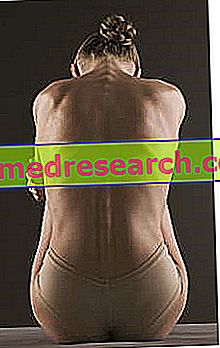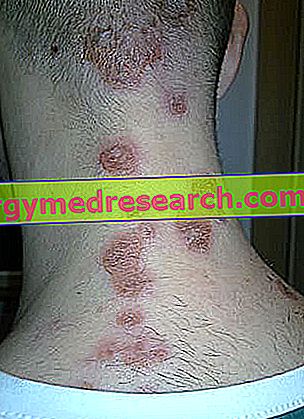Definition of vulvodynia
The vulvodynia delineates a chronic painful perception of vulvar interest, characterized by burning, irritation, swelling and redness, a condition that is very different from itching. Vulvodynia, only rarely, is accompanied by observable physical traumas: in this regard, the disorder has been classified as "exclusively psychosomatic" or even "psychogenic".

The problems related to vulvodynia have been re-evaluated and reconsidered by researchers only in recent years: despite the actual explosion of current interest, vulvodynia still remains an intricate medical problem, a Macchiavellian disorder that torments doctors, sexologists and gynecologists, incapable of find a unique explanation.
Analysis of the term
Vulvodynia, vulvar vestibulitis and vestibulodynia are apparently synonyms that lead to chronic inflammation of the vulvar area: the term "apparently" is entirely appropriate, since the three synonyms - which refer to the same disorder - differ in subtle facets. Indeed:
- "Vestibol ite vulvare" indicates an inflammatory condition: it is an adequate term, expressed by the suffix -ITE (inflammation). It is necessary to underline that the vestibulitis refers to an inflammation separated from a particular cause that predisposes it, often not linked to the redness at the level of the mucosa. In other words, the term vestibulite indicates the mere inflammation of the vulvar area, without particular causal factors and without pain.
- Vulvo dinia and vestibulo dinia, both characterized by the Greek suffix –DINIA (pain), more precisely associate inflammation with pain.
Focusing mainly on the last two pseudo synonyms (vulvodynia and vestibulodinia), we can notice some subtle differences; although both words are etymologically linked by the suffix –dinia, the analysis of meaning differentiates them. Vestibulodynia, in general, refers to a disorder that remains limited in a given area, while vulvodynia is usually the result of vestibulodynia, since in the latter case, inflammation and vulvar pain are generalized.
Furthermore, in the complex analysis of meaning, vulvodynia is distinguished from vestibulodynia and vestibulitis: the vulva dinia is the vulvar pain, while the vestibulo dinia and the vestibule delineate inflammation and / or pain that affects the vestibule .
In common language, for "comfort" the three terms are used indiscriminately.
Symptoms
"Sexual intercourse is an atrocious ordeal for some women suffering from vulvodynia, while for others the sexual act is not a problem". This statement heralds the complexity of the symptom picture associated with vulvodynia which, not by chance, is a disorder represented by an intricate and complex interweaving of causal factors, which we will analyze in detail in the next paragraph.
Vulvodynia was first described by Dr. Friedrich in the late 1980s, and the line of symptoms analyzed by the author himself is still maintained, which is summarized in:
- Erythematous manifestation at vulvar and / or vestibular level of varying degrees of intensity;
- Hypersensitization of the vestibular tissue;
- Possible dyspareunia (pain during sexual intercourse) and discomfort on contact with the vaginal vestibule; vulvodynia is the main cause that causes dyspareunia in women of childbearing age.
The symptoms described by Friedrich are sometimes also associated with other signs that complete the syndrome: irritation, feeling of abrasion, dryness, typical sensation of "pinpricks", tension, burning, perception of having cuts on the mucosa, de-epithelialization.
Not surprisingly, we talked about vulvodynia as a real syndrome that, by definition, represents a problematic and complex symptomatology, which contains numerous symptoms.
Causes of vulvodynia
Vulvodynia has been diagnosed in 8-12% of women who undergo routine gynecological examinations, while remaining an almost vague disorder. It is puzzling how a good portion of the women who have been diagnosed with vulvodynia have previously been evaluated only as "suffering from psychological and psychotic pain".
Vulvodynia is a heterogeneous and subjective disease, triggered by many factors that act in symbiosis: it is the complexity of all the predisposing elements that triggers the disease, not the single cause. Precisely for this reason, the diagnosis of vulvodynia appears particularly difficult: the doctor must know the patient and pick up all the signals so that he can discover the underlying motivation; consequently, the affected woman can be treated in the most appropriate manner.
Among the possible causes, repeated vaginal and bladder bacterial infections certainly play an important role in the manifestation of vulvodynia; often, women with this disorder have a genetic predisposition to inflammation, and it has been verified that the fibers in the nerve of the buccal and vulvar area of vulvodynamic patients are very numerous and voluminous.
Other women affected by vulvodynia have hypercontractivity in the muscles surrounding the perianal and vulvar area.
As has been repeatedly emphasized, the psychological-sexual aspects have a great impact on the manifestation of vulvudinia: many affected women present a lived history of sexual harassment, trauma, abuse, and considerable relational difficulties, factors that predispose a psycho-biological deterioration.
In vulvar vestibulitis, women often complain of serious problems with couples, decreased sexual desire, difficulty in reaching pleasure and "fear" of penetration (vaginism), associated with pain during intercourse (dyspareunia).
Classification of vulvodynia
Given the complexity of the phenomenon, vulvodynia is generally classified based on the characterization of the symptoms and on the basis of the location of the disorder.
Focusing attention on the symptomatology, one speaks of vulvodynia caused when the symptoms felt are due to vaginal penetration, rubbing or even to contact. Vulvodynia is spontaneous when the woman is constantly experiencing pain or discomfort, even in the absence of stimulation.
Based on the location of the pain, generalized vulvodynia is distinguished (the disorder affects the vulvar area, the perineum and the perianal area) from localized vulvodynia, in which the pain target can be the vestibule ( vestibulodynia ) and / or the clitoris ( clitoridodynia ).
There may also be mixed forms of vulvodynia, which are accompanied by more symptoms.
Furthermore, the dysesthetic or essential vulvodynia represents the most frequent form of vulvodynia in the post menopausal period, accompanied by a pain that extends to the rectum and to the urethral zone, as well as vulvar.
Diagnosis
The diagnosis of vulvodynia consists of the swab test (or Q-tip test), described, once again, by Friedrich: with the help of a cotton swab, the doctor exerts a slight pressure in some precise points of the vestibular area: the woman affected by vulvodynia it reacts exaggeratedly, complaining of an annoying sensation of pain.
Furthermore, the vulvalgesiometer is a useful tool for the assessment of pain in the vulva; electromyography is used to verify the (excessive) reactivity of the levator muscle.
Also the quantification of the intensity of the perceived pain, associated to the location of the same ( pain mapping ), are two important diagnostic factors useful for identifying the symptoms that accompany the vulvodynia: in this regard, women are asked to evaluate, through a test paper, some parameters that will help the doctor in choosing the most appropriate therapy for the patient.
The pain must not be considered solely psychogenic, rather, it must be interpreted and translated in all its facets, even in the most hidden ones: "paraphrasing" the symptoms, the doctor must intuit the woman's problem and direct it towards the treatment at she more appropriate.
Treatments
The therapeutic strategies for the healing of vulvodynia cannot be limited simply to the treatment of symptoms, but must also control the physiopathological aspects.
Psychotherapy helps heal the psychological disorders that are hidden in vulvodynia, but psychological treatment alone rarely manages to completely heal the disorder.
Some women are prescribed pain medications, which exert action by decreasing vulvar pain; drugs can be taken by mouth, but even creams with local anesthetic action are able to alleviate pain, albeit transiently. Drugs, however, cannot and should not be used for a long period of time, as they often involve undesirable side effects.
When women suffering from vulvodynia have a spastic alteration of the perianal - vulvar musculature, a particular rehabilitation is recommended: the help of an instrument, called biofeedback, is able to trace sound and written graphs that translate muscle tone, for the purpose to interpret and revise vulvar musculature.
Curious is the importance of diet in vulvodynia: foods rich in oxalates should be avoided by women suffering from vulvodynia, as these substances are excreted with urine and, at high concentrations, could form microcrystals at the kidney level and accentuate the burning in the women affected by vulvodynia.
In the most serious cases, the doctor could subject the woman to delicate surgery, aimed at cutting off a part of the mucosa with related nerve endings. The outcomes are not always positive, therefore surgery represents the "last resort" for the resolution of vulvodynia.
Summary
To fix the concepts ...
| Disorder | Vulvodynia |
Features | Chronic painful perception of vulvar interest, characterized by burning, irritation, swelling and redness, which is very different from itching |
Pseudo synonyms | Vulvodynia, vulvar vestibulitis and vestibulodynia |
Symptomatic picture of vulvodynia |
|
Etiological research | Almost vague, heterogeneous and subjective disorder, triggered by many factors:
|
Classification of vulvodynia |
|
Vulvodynia diagnosis |
|
Therapeutic treatment against vulvodynia | Psychotherapy, painkillers, creams with local anesthetic action, rehabilitation (to correct the spastic alteration of the perianal-vulvar musculature), delicate surgery. |



